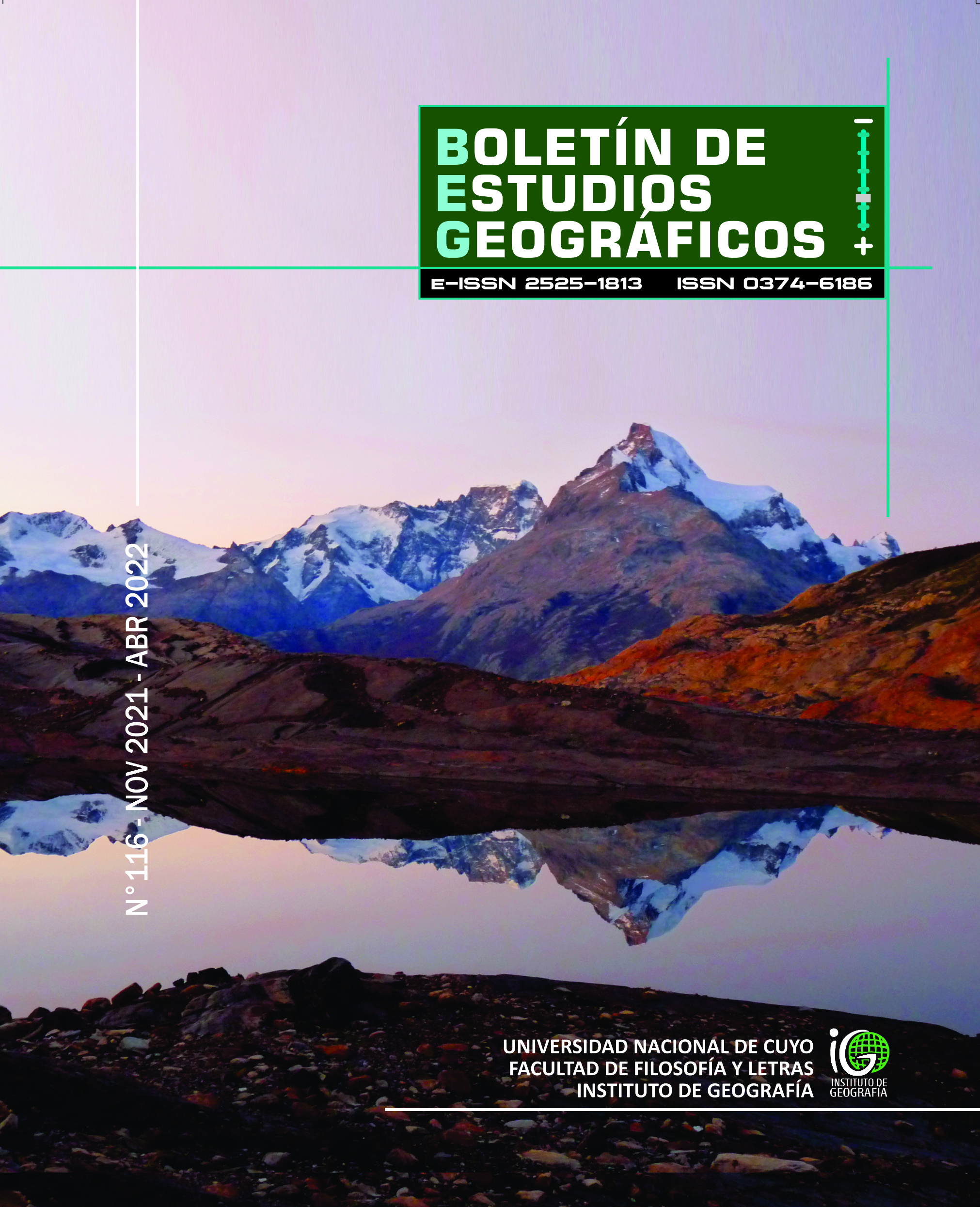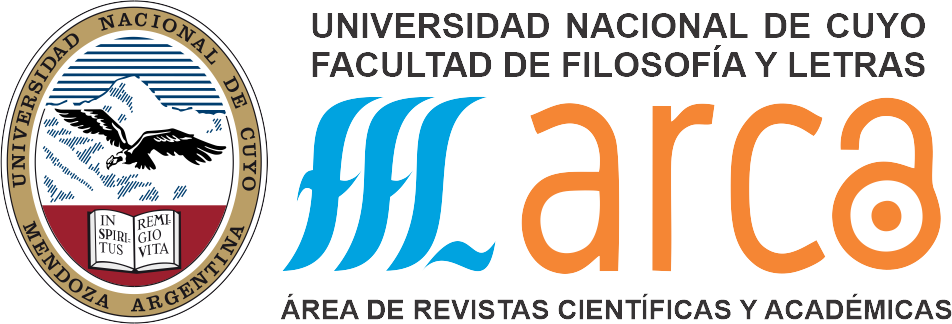Santa Cruz river basin’s glacier dynamic
fresh water of future
Keywords:
Glaciers and society, Santa Cruz river basin, Historical glacial dynamicsAbstract
The largest glacier area in Argentina is located in the Santa Cruz River Basin (CRS), Southern Patagonian Andes. The CRS concentrates 35% of the entire national glacier cover (including the sub-Antarctic islands), and 52% if only the Andes are considered.
Its 3023 km2 are distributed in a thousand glaciers, although between seven of them accumulate ~80% of that area (Viedma, Upsala, Onelli, Spegazzini, Mayo, Ameghino, and Perito Moreno). These seven glaciers end in proglacial lakes, which stimulate processes of acceleration, fracture, and detachment of glacial ice (detachment glaciers). The thesis aims to determine the multiscale relationships between the dynamics of the detachment glaciers of the CRS, the natural triggering processes, and their impacts on the geographic space. To this end, the analysis of the last two decades is proposed through different satellite platforms and the thematic information available. In this work, the glaciological indicators analyzed are frontal position changes and supraglacial melting events. For synthesis purposes, the results show a cumulative retraction of 19 ± 0.3 km during the whole study period, although with
heterogeneous individual behaviors. Between 1985 and 2017 the Upsala glacier retreated 8287 ± 60 m, at the same time Moreno glacier advanced 101 ± 60 m. Spegazzini glacier is another glacier that sustained its position in that period, immediately south of Onelli glacier which retreated 3069 ± 60 m. The above suggests the multicausal of glacial dynamics and the inexistence of a single forcer. In terms of melting events (2001-2016), the extent occupied by these has a marked seasonality, frequent during the summer months even at high summits (>3000 m). During the warm period (October/April) more than 50% of the glacier area was melting (with maximums of 75% in the summer of 2013). In contrast, in the cold phase, they were drastically reduced and even absent in the months of June-July. In CRS, melt events began to increase from 2010, with a positive trend. The consequences of glacial dynamics have played a key role in the possibilities for the configuration of humanized spaces. These places are structured according to these dynamics, either because of exposure to glacial hazards or because they represent the main source of foreign exchange for the basin: glacier tourism.
References
Ackerman, S. A., R. E., Holz, R. Frey, E. W. Eloranta, B. C. Maddux, y M. McGill. (2008). Cloud detection with MODIS. Part II: Validation. Journal of Atmospheric and Oceanic Technology 25 (7): 1073-86. https://doi.org/10.1175/2007JTECHA1053.1.
Adaros, R. (2003). Sismicidad y Tectónica Del Extremo Sur de Chile. Memoria de Magister, Facultad de Ciencias Físicas y Matemáticas, Universidad. de Chile.
Bennett, M. y Glasser, N. .(2009). Glacial Geology: Ice Sheets and Landforms, 2nd Edition. Second. Oxford: John Wiley & Sons.
Consejo Federal de Inversión. (1973). Departamento Lago Argentino. Estructura económica y social. Santa Cruz. http://biblioteca.cfi.org.ar/wp-content/uploads/sites/2/1973/01/12401.pdf.
Cuffey, K.M., y Paterson, W.S.B. (2010). The physics of glaciers. Editado por Academic Press. Journal of Glaciology. Amsterdam: Cambridge University Press. https://doi.org/10.3189/002214311796405906.
Garreaud, R. D. (2009). The Andes climate and weather. Advances In Geosciences 7 (1): 1-9. https://doi.org/10.5194/adgeo-22-3-2009.
Garreaud, R. D., Vuille, M., Compagnucci, R., y Marengo, J. (2009). Present-day South American climate. Palaeogeography, Palaeoclimatology, Palaeoecology 281 (3-4): 180-95. https://doi.org/10.1016/j.palaeo.2007.10.032.
Ghiglione, M. C, Suarez,F., Ambrosio, A., Poian,G., Cristallini, E., Pizzio, M.F., Reinoso, M.,et al. (2009). Structure and Evolution of the Austral Basin Fold-Thrust Belt, Southern Patagonian Andes. Revista de la Asociación Geológica Argentina 65 (1): 215-26.
Hall, D., Cullather, R,. DiGirolamo, N., Comiso, J., Medley, B. y Nowicki,S. (2018). A multilayer surface temperature, surface albedo, and water vapor product of Greenland from MODIS. Remote Sensing 10 (4): 1-17. https://doi.org/10.3390/rs10040555.
IANIGLA-Inventario Nacional de Glaciares, y Ministerio de Ambiente y Desarrollo Sustentable de la Nación. (2018). Resumen ejecutivo de los resultados del Inventario Nacional de Glaciares. www.glaciaresargentinos.gob.ar.
Jansson, P., Hock, R. y Schneider,T. (2003). The concept of glacier storage: a review. Journal of Hydrology 282: 116-29. https://doi.org/10.1016/S0022-1694(03)00258-0.
Kraemer, P., y Riccardi,A. (1997). Estratigrafía de la región comprendida entre los lagos Argentino y Viedma (49 40’-50 10’lat. S). Revista de la Asociacion Geologica Argentina 52 (3): 333-60.
Lo Vecchio, A., Lenzano, M., Richiano, S., y Lenzano,L. (2016). Lithologic identification and characterization using ETM+ (Landsat 7). Study case of the Upsala glacier basin, Argentine. Revista de Teledeteccion 2016 (46): 57-72. https://doi.org/10.4995/raet.2016.4482.
Lo Vecchio, A. (2020). Dinámica glaciar de la cuenca del río Santa Cruz, Andes Patagónicos Australes: estudio y análisis multiescalar mediante el uso de geotecnologías, Universidad Nacional de Cuyo.
Martinic, M. (1988). Actividad volcanica historica en la region de Magallanes. Revista Geologica De Chile 15 (2): 181-86. https://doi.org/10.5027/andgeoV15n2-a07.
Martinic, M. B. (2008). Registro historico de antecedentes volcánicos y sísmicos en la patagonia austral y la tierra del fuego. Magallania 36 (2): 5-18. https://doi.org/10.4067/S0718-22442008000200001.
McCabe, M. F, Chylek, P. Manvendra K D. (2011). Detecting ice-sheet melt area over western Greenland using MODIS and AMSR-E data for the summer periods of 2002-2006. https://doi.org/10.1080/01431161.2010.501830.
Meier, M.F., y Roots E.F.. (1982). Glaciers as a water resource. Nature and Resources. http://agris.fao.org/agris-search/search.do?recordID=XF19830896816.
Ministerio de Hacienda. 2018. «CARACTERIZACIÓN SOCIO-PRODUCTIVA». Santa Cruz. http://www2.mecon.gov.ar/hacienda/dinrep/Informes/archivos/santa_cruz.pdf.
Moragues, S., Lenzano,M.G., Moreiras, S., Lo Vecchio, A., Lannutti,E. y Lenzano,L. (2019). Slope instability analysis in South Patagonia applying multivariate and bivariate techniques on Landsat images during 2001–2015 period. CATENA 174 (marzo): 339-52. https://doi.org/10.1016/j.catena.2018.11.024.
Moragues, S., Lenzano,M.G., Moreiras,S., Lo Vecchio,A., Lannutti, E., Lenzano, L. (2019). Slope instability analysis in South Patagonia applying multivariate and bivariate techniques on Landsat images during 2001–2015 period. CATENA 174 (marzo): 339-52. https://doi.org/10.1016/j.catena.2018.11.024.
Orlove, B. S., Wiegandt, E.y Luckman,B. . (2008). Darkening peaks : glacier retreat, science, and society. University of California Press. https://books.google.com.ar/books?hl=es&lr=&id=vgJ1EKyK8RoC&oi=fnd&pg=PA3&dq=darkening+peaks&ots=Wh0xE5xDX8&sig=xeswnRma8WenH2CP9L_cMNSMqwU&redir_e
sc=y#v=onepage&q=darkening peaks&f=false.
Østby, Torbjørn I., Schuler,T. y Westermann,S.. (2014). Severe cloud contamination of MODIS Land Surface Temperatures over an Arctic ice cap, Svalbard. Remote Sensing of Environment 142: 95-102. https://doi.org/10.1016/j.rse.2013.11.005.
Penalba, O. y Rivera, J.A. (2013). Future Changes in Drought Characteristics over Southern South America Projected by a CMIP5 Multi-Model Ensemble. American Journal of Climate Change 02 (03): 173-82. https://doi.org/10.4236/ajcc.2013.23017.
Penalba, O., y Rivera,J. A. (2016). Regional aspects of future precipitation and meteorological drought characteristics over Southern South America projected by a CMIP5 multi-model ensemble. INTERNATIONAL JOURNAL OF CLIMATOLOGY 36: 974-86. https://doi.org/10.1002/joc.4398.
Secretaría de Estado de Ambiente. (2017). Informe Técnica N° 41. Comisión Evaluadora del Estudio de Impacto Ambiental: "Proyecto Aprovechamiento Hidroeléctrico del río Santa Cruz, Represas Presidente N. Kirchner y Gob. J. Cépernic" http://saludsantacruz.gob.ar/secretariadeambiente/wpcontent/uploads/2017/11/dictamen-tecnico-represas.pdf.
Shin,S., Minowa,M., Daiki Sakakibara,D., Skvarca, P., Sawagaki,T., Ohashi,Y., Naito, N.,y Chikita,K. 2016. Thermal structure of proglacial lakes in Patagonia. Journal of Geophysical Research: Earth Surface 121(12): 2270-86. https://doi.org/10.1002/2016JF004084.
Vich, A., (1996). Aguas continentales: formas y procesos. Primera. Mendoza: Centro de Economía, Legislación y Administración del Agua.
Wan, Z. (2013). MODIS Land Surface Temperature Products Users’ Guide. Contract, (30). https://doi.org/10.5067/MODIS/MOD11B3.006.
White, A., y L. Copland. (2015). Decadal-scale variations in glacier area changes across the Southern Patagonian Icefield since the 1970s. Arctic, Antarctic, and Alpine Research 47 (1): 147-67. https://doi.org/10.1657/AAAR0013-102.
Williams, Richard, S. y Ferrigno,J. (2012). State of the Earth’s Cryosphere at the Beginning of the 21st Century: Glaciers, Global Snow Cover, Floating Ice, and Permafrost and Periglacial Environments - Global Snow Cover. Satellite Image Atlas of Glaciers of the World, 254. http://pubs.usgs.gov/pp/p1386a/gallery1-fig16.html.
Downloads
Published
How to Cite
Issue
Section
License

This work is licensed under a Creative Commons Attribution-NonCommercial 4.0 International License.


























